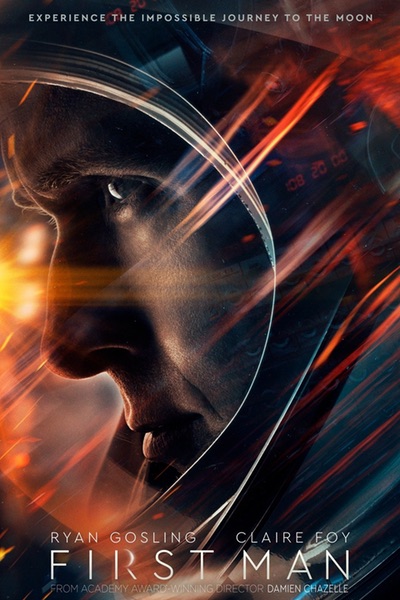Review: First Manby Andre Bormanis
|
| Throughout his life Armstrong demonstrated an unwavering humility. This leaves the filmmakers little choice but to build his story around famous incidents and events in the Gemini and Apollo programs, culminating in the Moon landing. |
Such a person presents a unique challenge for filmmakers seeking to do his life and extraordinary achievements some degree of justice. Director Damien Chazelle (La La Land) and screenwriter Josh Singer (Spotlight) are both Oscar winners, and both exceptionally talented storytellers, and First Man is a worthy film in many respects. It will certainly draw an audience from among those of us who remember and revere the most exciting years of The Space Age. Unfortunately, First Man offers only the barest glimpse into its title character, making it a somewhat disappointing dramatic experience.
The movie begins with a harrowing aerial sequence: Neil Armstrong flying the X-15 rocket plane to an altitude of 140,000 feet. It’s intense, loud, and jarring (and cinematically speaking, owes more than a little to the sequence in The Right Stuff where Chuck Yeager breaks the sound barrier in the X-1). The flight is shown almost entirely from Armstrong’s point of view, inside the cockpit. After he cuts the engine, his vehicle comes dangerously close to skipping off the atmosphere. Armstrong’s quick thinking and extraordinary piloting skills barely avert disaster. But for the future astronaut, played by Ryan Gosling with both subtlety and depth, it’s basically just another day at the office.
Claire Foy, best known for her recent portrayal of the young Queen Elizabeth in the Netflix series The Crown, plays Armstrong’s wife Janet. She’s dutiful and adoring of her husband, living up to the expectations of her era and her position as the wife of an astronaut. She shows an emotional intelligence on par with Armstrong’s keen mechanical aptitude. Some of the most interesting moments of the film revolve around Jan’s attempts to draw her husband out, especially in his relationship with their two young boys. The most emotionally effective scenes in the movie revolve around her.
Neil and Janet also had a daughter, Karen, who died as a toddler. The film suggests that Armstrong decided to apply to the Gemini program in part to give his family a fresh start in the wake of this tragedy, and attempts to use this loss as a window into Armstrong’s psyche. Unfortunately, this element of the story feels strained and a little manipulative. The moments depicting Armstrong reflecting on this loss are almost believable in the context of the movie, but are almost certainly fabricated.
Throughout his life Armstrong demonstrated an unwavering humility. He lacked the charisma of a John Glenn, that straightest of straight arrows, or the natural charm of a Chuck Yeager. This leaves the filmmakers little choice but to build his story around famous incidents and events in the Gemini and Apollo programs, culminating in the Moon landing. I would guess that most people who see the film already know how the story ends (spoiler alert: they landed and made it home safely). Some movies can sustain interest and tension even when the outcome is widely known (Apollo 13) but this one seems to lose momentum the closer Armstrong gets to the moon.
| Contrary to some reports, the American flag is prominently featured on the surface of the Moon, on the hulls of rockets, and on spacesuits. |
There are a few tangents on the flight path, such as cuts to various protestors and commentators wondering if America should be spending so much money on Moon landings when there are so many problems here on the ground. A young Gil Scott Heron even recites a few lines from “Whitey on the Moon.” However, these scenes feel more distracting than illuminating. If Armstrong ever expressed any feelings about the public debate, he kept them to himself, at least in this movie.
One person who will certainly not be pleased with First Man is Buzz Aldrin. The film goes out of its way to make him look like an arrogant, insensitive jerk. The actor who plays him is also, inexplicably, bald.
Contrary to some reports, the American flag is prominently featured on the surface of the Moon, on the hulls of rockets, and on spacesuits. Even the most ignorant viewer will have no trouble understanding that America was the first (and still so far the only) country to send human beings to the Moon and return them safely to Earth.
In the end, is there any way to make a movie that can really capture what Armstrong, NASA, the United States, and ultimately the human race accomplished on July 20th, 1969? Maybe some future artist who actually travels to the Moon will be able to tell their story in a way that makes us feel like we’ve been there too. I hope First Man is successful if for no other reason than to remind the world that global leadership once meant something to America, and we humans are capable of doing great things.
Note: we are temporarily moderating all comments subcommitted to deal with a surge in spam.
